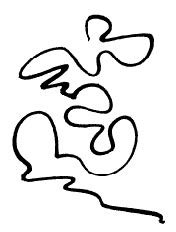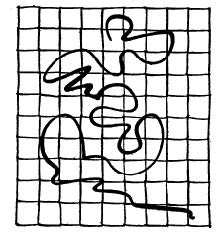I have written before about the semiotic/metaphor of the rhizome (https://safetyrisk.net/like-a-rhizome-cowboy/ ), introduced by Deleuze as a model for understanding learning and knowing. Deleuze was interested in ‘becoming’ and in the ‘hidden third’, a common concept in Transdisciplinarity. Deleuze (https://monoskop.org/Gilles_Deleuze) understood the metaphor of the rhizome as way of understanding ecological complexity, whilst the ‘tree of knowledge’ metaphor represents order, linear and visual thinking.
The rhizome describes the matted and hidden roots of the plant that tangle about obstacles and each other in search of being. The rhizome serves as a sign for the nature of wicked problems and also for what Luhmann, Varela and Maturana called ‘autopoetic social ecologies’ . An ecology is ‘autopoetic’ (self-sustaining) as a social networks that self-sustains mysteriously as if automatically driven by a life force and the will to live and be. We see aspects of this life force in the theory of evolution, adaptation and survival of the fittest theories.
The rhizome captures the idea of a multi-tangled web of
being that does not follow a single path or linear trajectory as is common in
many safety models (eg. swiss cheese, bow tie etc). I discussed this in my book
(for free download https://www.humandymensions.com/product/fallibility-risk-living-uncertainty/)
Fallibility and Risk, Living With
Uncertainty pp. 92, 96, 98, 99, 101, 111 and 132. If one was to use the
metaphor of swiss cheese to represent the nature of reality it would have to
look something like Figure One. Rhizome
Swiss Cheese.
Figure One. Rhizome Swiss Cheese
This is why many models of incident investigation on the market don’t work because, they impose a linear, mechanistic assumption worldview on to an incident and then investigate to find the match to indoctrinated assumption. This is not what SEEK (https://cllr.com.au/product/seek-the-social-psyvhology-of-event-investigations-unit-2/ ) does. Life is far more messy and ‘wicked’ that Safety supposes.
The beauty of the rhizome metaphor is that as a semiotic it subverts the idea that objectivity can be found in text in a binary way. By stepping outside of the binary argumentative model of logic, the semiotic creates and third way of understanding knowing. Delueze rejected the idea of linear progressive knowledge building up to a desired goal. He also rejected the idea that learning could involve resemblance and repetition, so common to models of training in safety.
Deleuze understands meanings and new concepts as artistic musical creations and uses the language of music, cinema and art to better capture the nature of learning and becoming. Why does this matter for risk?
Risk is so often about the uncertain, unknown and unseen. As
fallible humans we can’t see the connections between events neither the hidden
trade-offs in the systems we create. Rhizomatics is a strategy of thinking and
learning differently about interconnectedness and autopoesis. It is a strategy
of trying to make the unconscious conscious, like a performing art that seeks
to make the feeling and emotion of the artists visible. Rhizomatics is not just
a theory but a way of seeing the world, a way of envisioning the nature of risk
Because we know from the Social Psychology of Visual Perception that humans
tend to see what they want to see. They impose order on disorder as in Figure Two. Disorder; Figure 3, Order on Disorder.
Figure Two. Disorder
Figure 3, Order on Disorder
This is how a worldview of Safety shapes everything from
notions of causality, complexity and anthropology. Each school of thought in
risk and safety (https://safetyrisk.net/a-great-comparison-of-risk-and-safety-schools-of-thought/ ) carries such an ontology that shapes everything from zero to human factors,
including SPoR. There is no neutral objective theory of risk and safety. This
is how a transdisciplinary approach, that brings together and reaches across
theories, can develop more holistic solutions to risk as a wicked problem (https://safetyrisk.net/risk-and-safety-as-a-wicked-problem/ ).
The rhizome semiotic as a mediatory third, disturbs the binary
opposition between signifiers and signified or, between words and objects. This
is why all models offered in SPoR are triarchic, including covers of books,
tools in risk assessment and models like One
Brain Three Minds (https://vimeo.com/106770292;
https://vimeo.com/156926212). As with Deleuze, stepping out of the binary
discourse enables a dialectic and new way of learning that is experiential,
visual and somatic. Meaning is never ‘given’ but rather interpreted
ontologically and often in the convergence of paradoxical differance (Derrida) (https://www.tandfonline.com/doi/abs/10.1080/10350339709360376?journalCode=csos20).
When we see the nature of being and the unconscious more as a rhizome we ask different questions of events, we SEEK different avenues in by-products and trade-offs and, we take on a different relational understanding about what drives people, purpose, meaning, self-sustaining ecologies and why people do things. In rhizomatics the burden of behaviourism sinks into the background and we begin to better support and manage events, systems of work and human adaptation.






Ooker says
I came across this post while searching for images of rhizome. I’m surprised that it even has connection in this field (I know everything has connection, but still :D). Thanks for the post.
Rob Long says
Ooker, I acknowledge your surprise but when it comes to risk and safety the rhizome is the perfect metaphor for the nature of uncertainty and risk.
I don’t know what discipline you come from but glad you found it helpful. The mono-disciplinary world of the risk and safety industry have no interest in critical thinking like this so nice to have your feedback.